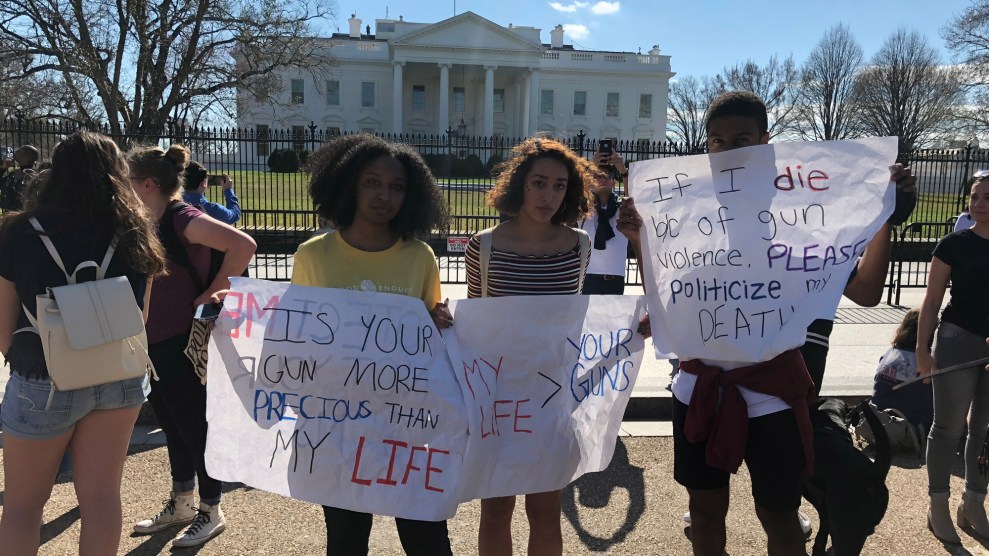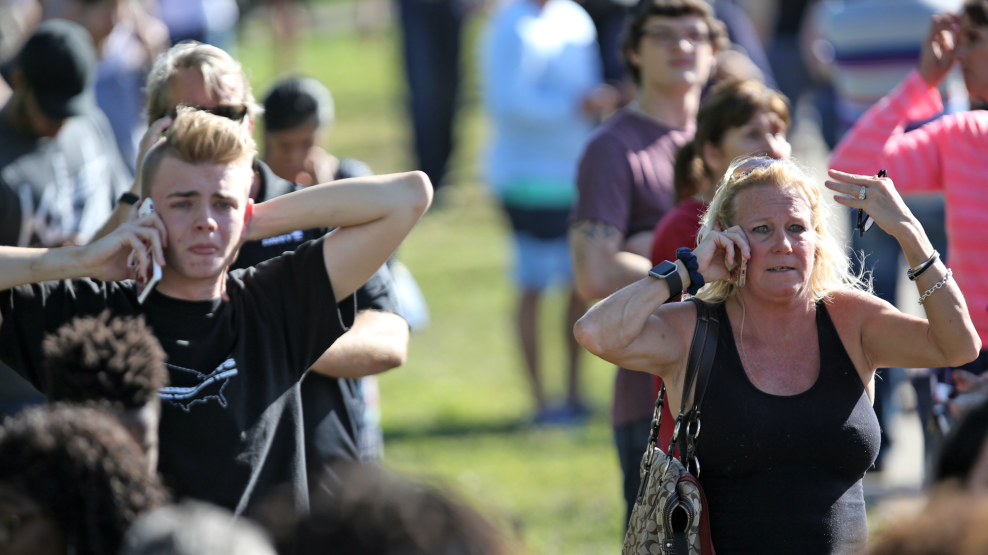
Dani Tylim was taking a math test at Marjory Stoneman Douglas High School in Parkland, Florida on February 14 when the fire alarm started ringing. Confused, the 18-year-old junior evacuated to a field by the school’s tennis courts. That’s when she heard the gunshots.
“I thought it was a drill,” she told Mother Jones. “I heard about four gunshots and from there it got very chaotic and everyone started to run.”
Dani, who transferred from a nearby charter school to Stoneman Douglas last fall, said she’s had nightmares about being in a school shooting, but never imagined she would live it. “One of my biggest fears was a shooting at my school,” she said. “This has been something on my mind.”
She certainly never thought she would lose 17 community members—14 students and 3 staff—in one of the deadliest school shootings ever.
But Dani was not the first member of her family to survive a shooting. In 1999, Dani’s two older brothers were enjoying summer camp at a Jewish community center in Los Angeles when a man, later identified as having ties to white supremacist groups opened fire.
“My husband and I over the years always said it could never happen again,” Dani’s mother, Carrie, who was pregnant with her daughter at the time of the first attack, told Mother Jones. “Lightning doesn’t strike twice. But 19 years later, I’m getting a text from my daughter that there’s an active shooter at her school. It’s just been hell since. I can’t believe 19 years later we’re going through the same thing.”
The Tylims are not the only family who have experienced such an unfortunate and disturbing coincidence. In a viral tweet last week, another Parkland shooting survivor, and Tylim’s best friend, senior Carly Novell, revealed her grandfather had hid in a closet—as Novell herself had done—to elude a mass shooter almost 70 years earlier. And USA Today reported last week that the mother of a 14-year-old Stoneman Douglas student had survived the shooting at a Fort Lauderdale airport last year.
“You never think this would happen twice,” Dani’s brother Jordan told Mother Jones. “It seems like a once in a lifetime thing when this happens.”
The Tylim family moved to Florida from California in 1996, but had returned to Los Angeles in 1999 to spend the summer. Jordan, who graduated from Stoneman Douglas in 2014, and Max, the eldest Tylim sibling, were three and nine at the time. They were both at camp when Buford O. Furrow Jr. walked in and shot and injured five people, including two children. Furrow later fatally shot a postal worker and turned himself in to the FBI the next day, telling authorities he “wanted to send a message to America by killing Jews.”
Max was bussed away from the center right after the shooting began, according to Carrie. Jordan was in a classroom next to the lobby where Furrow fired more than 70 rounds with a submachine gun. Jordan said although he was young, he distinctly remembers hearing loud noises and being told to play hide-and-seek by his counselor.
Carrie, who was two months pregnant at the time, was about 30 minutes away from the center when she saw reports of the shooting on the news. She rushed to the scene, but when she arrived she realized she’d potentially put herself, and her unborn baby, in danger: Furrow had not yet been caught.
As a recent graduate of Stoneman Douglas, Jordan Tylim, now a college student in Miami, said although he wasn’t there for the shooting, he might as well have been.
“The building that it happened in, I spent 180 days every year there for four years,” he said. “I know exactly where it happened. Students were killed in the hallway I walked in every day for four years.”
In the days following last week’s massacre, student survivors have been outspoken in their calls for gun control and congressional action, appearing on media outlets including CNN and Fox and using social media, mostly Twitter, to plead for change. On Wednesday, students across the country staged walkouts and marched for stronger gun laws, and hundreds of teenagers protested outside the White House. The youth-led movement may signal a tide change for the deadlock on gun control: Parkland survivors are planning multiple national demonstrations for the coming months, including one dubbed the “March For Our Lives” on March 24. President Donald Trump hosted a “listening session” for students and parents Wednesday, where he said he would strengthen background checks for purchasing firearms.
Jordan Tylim, taking a cue from the young activists, said he plans to take at least the next month off from school to help the students “see out their vision.” “I fear for people who oppose us, because these kids are relentless,” he said. “This will be the straw that breaks the camel’s back.”
Reflecting on the 19 years since the LA shooting, when her life had not yet begun, Dani Tylim said the fact that her family has faced gun violence twice shows nothing has changed.
“Because it’s affected my family twice, that just goes to show that this should not be happening,” she said. “It should not have affected a family even once in a lifetime.”
















